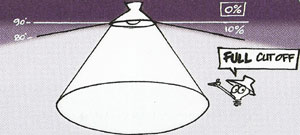 (FCO) floodlights are permitted but not encouraged.
(FCO) floodlights are permitted but not encouraged.Text shown in blue is not part of ordinance but part of comments added on this web site for illustration
[a] The purpose and intent of this article is to regulate aesthetic features on commercial building sites to: improve community appearance by requiring developments to use designated exterior color palettes, provide finish materials that enhance the visual interest and regional character of a building, address the human scale through the use of architectural features and detailing, and provide well designed exterior lighting.
[a] This article is applicable to the publicly visible portions of building elements, as defined herein, in new commercial (non-residential), multi-family (more than three dwelling units), institutional, and industrial uses. Each element of a building shall be evaluated independently for public visibility.
[b] If building elements are not publicly visible at the time of construction due to existing site features (earth berms, heavily wooded areas, existing buildings to remain), then these existing site features must remain indefinitely. If they are altered at any time to allow greater visibility, then the element made visible must comply with the standard.
[c] This article is not intended to supercede more stringent requirements which may exist within the North Carolina Building Code.
[a] The purpose of this section is to regulate the intensity of exterior lighting. The intent is to prevent light from commercial developments from excessively illuminating the property in question, other properties, or the night sky.
[b] Only light fixtures which are categorized
as full cut-off (FCO) fixtures shall be permitted. The use
of fully shielded (FCO) floodlights are permitted but not encouraged.
(FCO) floodlights are permitted but not encouraged.
Illustration: FCO puts no light (0%) above the horizontal, and less than 10% of its light above an angle of 10 degrees below the horizontal.
[c] The following are specific standards for lighting intensity based upon the land use involved. Values are presented in allowable foot-candles (fc) maintained (measured horizontally) at grade and are to be averaged throughout the site to avoid hot spots, i.e. areas of extreme light intensity relative to the remainder of the site:
|
Land Use |
Minimum |
Maximum |
|
|
Pedestrian areas / sidewalks |
0.2 fc |
1.0 fc |
|
|
Building entries |
1.0 fc |
10.0 fc |
|
|
Street lighting |
0.2 fc |
1.0 fc |
|
|
Parking areas |
2.0 fc |
4.0 fc |
|
|
Playgrounds |
5.0 fc |
||
|
Sports grounds |
20.0 fc |
||
|
Site perimeter |
0.5 fc |
[d] Athletic fields must be illuminated with fixtures equipped with the manufacturer's glare control package. If the manufacturer does not offer a glare control package, the fixture specifications must be changed to a manufacturer that does offer a glare control package.
Example
at right, Musco Total Light Control™ 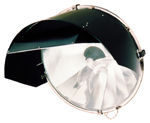
Example
below, GE POWR-SPOT ULC®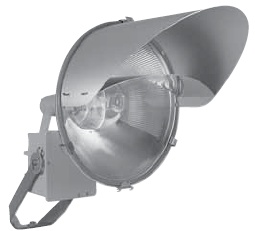
[e] Gas station canopies shall be illuminated at a maximum illuminance of 30 fc and individual fixtures shall be flush mounted or have the canopy edge below the lowest light-emitting point on the fixtures. All existing gas station canopies which exceed this standard shall be made compliant within seven (7) years of the date of adoption of this article.
Illustration below from Information Sheet 145 of the International Dark-sky Association:
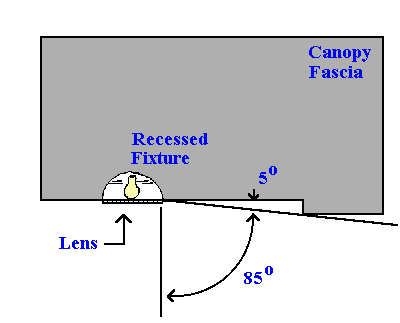 Ill
Ill
[f] Up-lighting may be used to illuminate a building, landscaping element or architectural feature, provided the lighting design has a maximum illuminance of 12 fc, measured in a vertical plane. Down lighting is preferred.
[a] Flexibility in administration is required for this article. When strict application of the standards within this article undermines other provisions of the UDO, then those other provisions take precedence. For example, the retaining wall height limitation may be increased to afford an opportunity to preserve significant or historic tree(s).
[a] Development site plans shall graphically illustrate, in both a site plan view and elevation view, those elements which are not publicly visible. Otherwise, each element of the project will be assumed by staff to be publicly visible.
[b] Elevation drawings of each side of the building shall be provided. The elevations shall have materials and colors rendered in such a way that each is distinct.
[c] Elevation drawings shall be accompanied by the following information for each portion of the building, corresponding to the design requirements set forth in Article XXII.
[1] Largest distance in plan between required features, and the elevation(s) on which this occurs.
[2] Largest distance in elevation between required features, and the elevation(s) on which this occurs.
[3] Number of features required and number present in each elevation.
[4] Name of each type of feature in elevation.
[d] Material samples shall be provided for all synthetic materials not specifically approved by Section 396.
[e] A lighting plan shall be submitted for staff review and approval prior to issuance of building permits. The plan shall contain the following information:
[1] An area lighting plan, drawn to scale, indicating all structures, parking lots, building entrances, vehicular and pedestrian traffic areas, vegetation that may interfere with lighting, and adjacent land uses that may be adversely impacted by the lighting. The plan shall contain a layout of all proposed fixtures by location, orientation, aiming direction, mounting height and type.
[2] The submission shall include, in addition to proposed area lighting, all other exterior lighting, e.g., architectural, building entrance, landscape, flagpole, sign, etc.
[3] A 10' x 10' illuminance grid (point-by-point) of maintained footcandles overlaid on the site plan plotted out to 0.0 footcandles, which demonstrates compliance with light intensity standards specified in Section 398.
Sample grid on design screen of a computer program. Click for larger version.
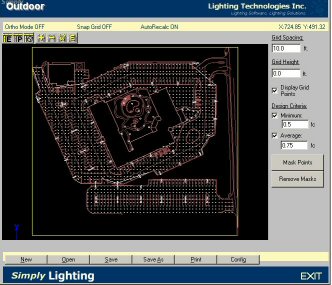
[a] Alternatives to the appearance standards provided herein may be permitted upon review and approval of the Community Appearance Commission. Applications containing alternatives shall be forwarded to the commission for review at their next regularly scheduled meeting.
[b] The Commission may approve such alternatives if it finds the alternatives involved meet the purpose and intent of the provisions contained within this article.
[c] Unless otherwise specified, the Commission's review and approval of any deviation from the standards contained herein is required prior to permit approval.